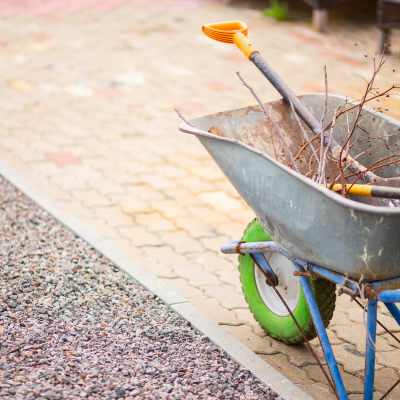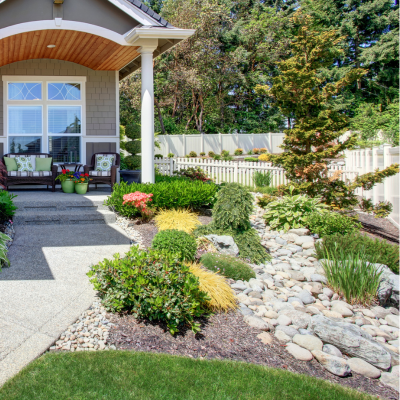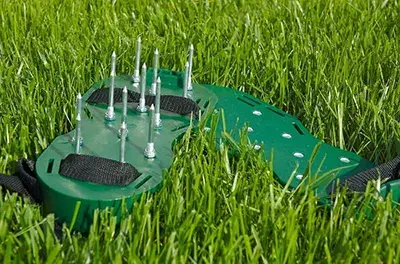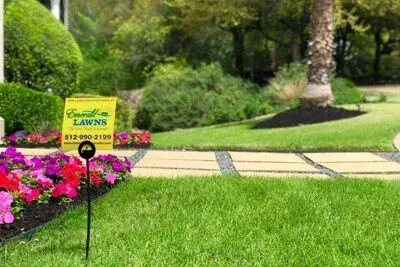Many Texans are seeking alternative landscape options for lawn areas with excessive shade, high foot traffic, or poor drainage.
But, there’s a lot to consider when making a change like this to your little piece of Texas.
Before we dive into the pros & cons, let’s answer the question on lots of folk’s minds, “What is hardscaping?”
Hardscaping is the “non-living” design features that adorn your outdoor space (stone walkways, patios, gravel, & more).
While similar to xeriscaping (sometimes pronounced as “zeroscaping”), because both significantly reduce water usage on a property, xeriscaping includes the installation of native plants and hardscaping does not.
Hardscaping Pros
Embrace Excessive Shade
We love Oak trees, Mountain Laurels, and Magnolia trees. Heck, we love all trees. While we cherish sipping drinks in the shade, a tree canopy could result in trouble spots on your grass or worse, turf death in certain areas.

- Grass needs sunlight for photosynthesis…which converts light energy into carbohydrates that feed the plant
- Trees also create a tug-of-war with turf for the nutrients in the soil
- If you’ve been troubleshooting this for long, you may have tried pruning the trees back, keeping turf height taller, and/or adding additional fertilization to the soil for both plants to thrive
- We began to wonder…rather than fight the ongoing battle of turf vs shade, why not concede to the trees and adjust your landscape for a beautiful win-win?
- Sideyards often fit right into this category as well, with the turf nearest to the house lacking the proper sunlight to thrive. And, unhealthy turf in those areas can actually foster weeds that spread to healthier areas of the lawn
Find Better Footing 
High-trafficked areas across lawns, around the patio, to/from the car, driveway, etc. are also perfect candidates for hardscaping.
Pavers provide the steady ground needed to access all of your favorite (or most frequented) places on your lawn
Less Aqua, Less Moolah
We’re not sure which benefit we prefer more here…both have an impact on our home and community.

- Watering a lawn can cost a few hundred dollars a year
- Texas dances in and out of drought most years, meaning the shared water source can run low, causing many local municipalities to restrict usage, and sometimes increase the costs of water in the summer
- The EPA shares, “In dry climates such as the Southwest, a household’s outdoor water use can be as high as 60 percent… as much as 50 percent of water used for irrigation is wasted due to evaporation, wind, or runoff.”
- Hardscaping replaces the need for extra watering to establish new sod or grass seed
Cons of Hardscaping
Higher Initial Investment
If you’ve gotten any quotes on installing rock or hardscaping, you know that it’s initially more expensive.
The projects we typically work on average around 500 sq ft. For a space of that size, the average cost to install sod in our area is $650.
It takes around two years to establish healthy turf out of new sod, meaning increased watering/frequency – without any guarantee that the excessive shade, slope, etc will be solved.
With the average cost of a rock installation of that size being around $1,000 for labor and materials, folks have found that replacing rock in those trouble areas is a much hardier, long-term solution.
Rock Bed Maintenance
Maintaining rock beds requires a different routine than the rest of your yard.
Although, mowing & replacing sod can be even more time-consuming & taxing!

Here’s what to expect with rock bed upkeep:
- Use a broom or rake to remove debris & leaves
- Alternatively, use a leaf blower or shop vac to clear out beds (so long as the rocks aren’t too small)
- Hose rocks to rinse off dirt
- Bed weed control
Plant Drainage
If you have plants incorporated into your rock bed design, drainage might be an issue. Depending on the rock size and bed depth, water can collect and drain improperly which impacts plant health. Poor drainage can lead to root rot and other complications if beds aren’t supervised or planned correctly. We’ve got a plan for that though…
- Design the area with plants that are tolerant to these conditions, or avoid using plants in beds completely
- Combine mulch in your design for desirable plants that won’t survive in a rock-only environment
- Use plant protector rings around the base of plants to provide space from surrounding rocks

Rock beds can replace areas of your lawn and become a creative and elegant way to reduce water waste and spending.
Trying to balance the aesthetics of your front lawn with your pocketbook can be a bit of a challenge. We hope this helped you with your decision.
Emerald Lawns Hardscaping
Here at Emerald Lawns, we began to offer hardscaping to help our customers with too much shade…and subsequently saw the many benefits of incorporating rock and pavers into a lawn design. We’d love to come out for a no-obligation design evaluation.
- We’ll assess your outdoor space for ideal hardscaping areas
- Share the various rock types we offer
- Dream up a plan together




